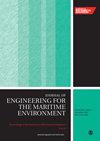支持数字孪生的结构完整性管理:关键审查和框架开发
IF 1.5
4区 工程技术
Q3 ENGINEERING, MARINE
Proceedings of the Institution of Mechanical Engineers, Part M: Journal of Engineering for the Maritime Environment
Pub Date : 2024-01-29
DOI:10.1177/14750902241227254
引用次数: 0
摘要
本文对被称为数字孪生的新兴技术及其在海洋结构完整性管理中的应用的文献进行了批判性评述。综述将与结构完整性管理相关的数字孪生定义为物理结构的虚拟表示,实时反映相同的结构状况。孪生是一个动态过程,包括减少虚拟表示与物理结构之间的差异,这需要借助监测数据来实现。关于海洋结构应用的最新技术,都需要创建一个有限元模型来表示物理结构。目前已提出了几种物理到虚拟互连的实用方案,但很少有研究人员专注于虚拟到物理的反馈。此外,大多数工作都只侧重于评估结构的当前状态。为了解决这个问题,我们提出了一个基于数字孪生的监测框架,并通过一个数值案例研究展示了三项关键使能技术,即模型更新、实时模拟和数据驱动预测。这些技术可实现结构诊断和预报,为检查/维护规划等决策提供支持。在案例研究的基础上,讨论了数字孪生的机遇和相关挑战。例如,为了充分发挥数字孪生的潜力,需要解决与监控系统相关的挑战,如标准化、增强长期应用的冗余度以及监控数据的质量保证。此外,由于数字孪生可以利用海量数据,因此还应该纳入专门的数据挖掘能力。本文章由计算机程序翻译,如有差异,请以英文原文为准。
Digital twin enabled structural integrity management: Critical review and framework development
This paper presents a critical review of literature on the emerging technology known as digital twin and its application in structural integrity management for marine structures. The review defines digital twin in relation to structural integrity management as a virtual representation of a physical structure that mirrors the same structural conditions in real time. Twinning is a dynamic process that involves reducing the discrepancy between the virtual representation and physical structure, which is achieved with the aid of monitored data. Regarding the state-of-the-art concerning marine structure applications, all require the creation of a finite element model to represent the physical structure. Several practical schemes for physical to virtual interconnection have been proposed, but few researchers have concentrated on virtual to physical feedback. In addition, most works have focused only on assessing the current states of structures. To address this, a digital twin-based monitoring framework is proposed and three key enabling technologies, namely model updating, real-time simulation, and data-driven forecasting are demonstrated using a numerical case study. Such technologies enable structural diagnostics, as well as prognostics, to support decision making such as inspection/maintenance planning. Based on the case study, the opportunities and associated challenges of digital twin are discussed. For instance, to fully exploit the potential of digital twin, challenges related to monitoring systems such as standardisation, enhanced redundancy for long-term application, and monitored data quality assurance need to be addressed. Further, because digital twin can avail a vast amount of data, a dedicated data mining capability should also be incorporated.
求助全文
通过发布文献求助,成功后即可免费获取论文全文。
去求助
来源期刊

CiteScore
3.90
自引率
11.10%
发文量
77
审稿时长
>12 weeks
期刊介绍:
The Journal of Engineering for the Maritime Environment is concerned with the design, production and operation of engineering artefacts for the maritime environment. The journal straddles the traditional boundaries of naval architecture, marine engineering, offshore/ocean engineering, coastal engineering and port engineering.
 求助内容:
求助内容: 应助结果提醒方式:
应助结果提醒方式:


